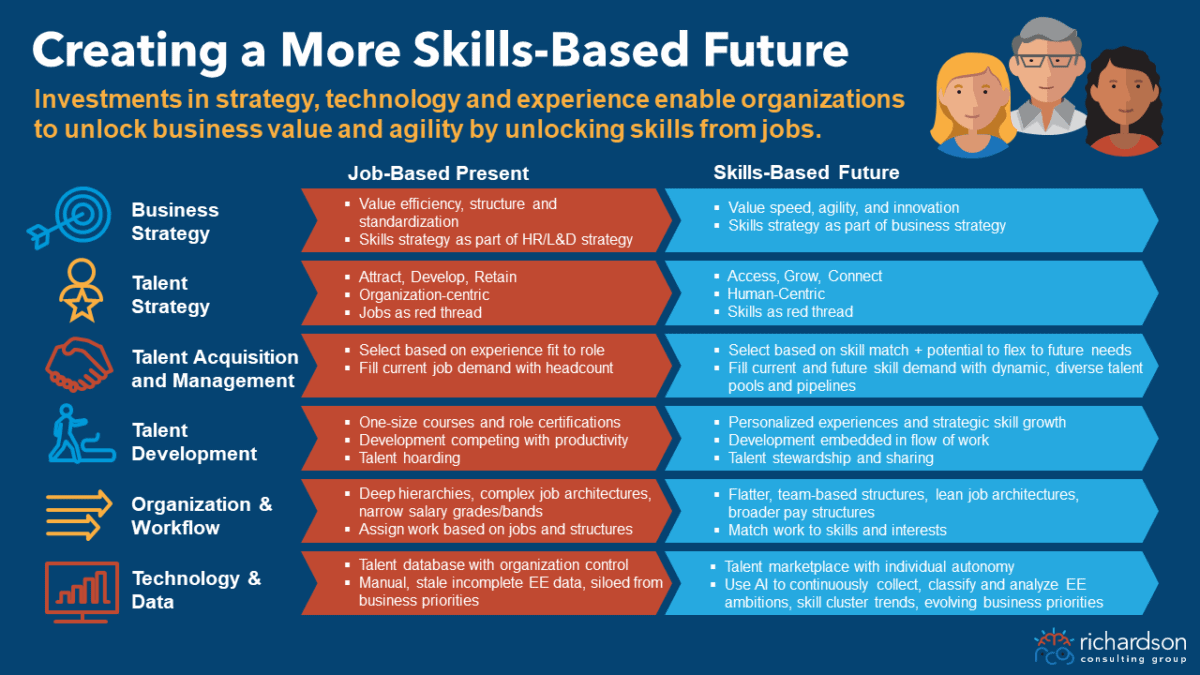
Are job descriptions dead? What’s all the buzz about the skills-based organization (SBO)? How can my organization get value from this new trend? How can I enhance the discussion of skills and skills strategy within my team?
Leaders bring these questions and more to our skills deep-dive roundtables. And our cross-industry working groups advance the skills conversation further and further with each session.
With the current level of interest from HR, talent, and learning and development leaders, making connections with others and having productive conversations is an important and valuable step, but that’s not the ultimate objective.
The goal is to see more organizations join the SBO trend and unlock the true potential of their workforce.
Why is this important?
According to a recent research by Deloitte, while 77% of business and HR leaders say flexibly moving skills to work is critical to navigating future disruptions, only 14% say they are matching skills to teams to create optimal team compositions to a significant extent.
It means 86% are still stuck in the traditional job and role approach. And that’s not good enough.
The good news is that those who have made the shift are 63% more likely to achieve business results than those who have not adopted skills-based practices.
Similar to that research, our recent expert skills roundtable session focused on advancing the discussion on what a skills-based organization is and how to begin the journey by connecting skills to a shared purpose.
Here is the crux of that discussion.
The Skills-Based Organization: Unlocking Skills from Jobs
The concept of a skilled-based organization (SBO) is gaining traction in HR, talent management, learning and development, and business operating systems. The overall theme is unlocking value by breaking down work to a more granular level and moving from a job focus to a skills focus.
Instead of thinking about traditional jobs, roles and functions, organizations are now thinking in terms of problems, opportunities, projects, and business outcomes. Hence, an employee with the right skill set is able to work on relevant projects that are of business priority, without the limitations of a job description or their functional alignment.
In hiring, the notion of a skills-based organization shifts the focus from matching candidates to job descriptions to hiring for skills that can benefit the organization, now and in the future. When assigning work, the focus is on skill sets rather than departments, titles, and jobs.
This concept is becoming more relevant within and outside the C-suite because of its impact on individuals and organizations. It promotes talent mobility, increases business agility, improves productivity, and opens more career opportunities for individual employees.
At the organizational level, it is the key to adapting to changes in the business environment, attracting and retaining top talent, and staying competitive and ahead of trends.

The idea affects every element of the talent process and experience, from hiring to compensation, workforce planning, training and development, strategy, and workflow organization.
For example, in learning and development, the focus is now on personalized experience and skills development aligned to business needs. This represents a shift from generic courses and certifications linked to jobs and roles that may or may not drive productivity.
Despite the growing importance, this skills-based approach to work and HR activities represents a trend and not a lived experience for most organizations.
It is happening at different paces depending on the industry and function. For example, many technology organizations and IT departments are leading the trend by adopting Agile practices that emphasize flexible roles, learning and skill-building as an expected outcome of project work.
You can join the discussion and get more insights from experts through our monthly roundtable sessions on various elements of the topic. You can also subscribe to our LinkedIn newsletter to get more updates on key discussions and best practices from each session.
Building Skills Culture Through Shared Purpose: Example of a Non-Profit Organization
In a world where more and more organizations are recognizing the increasing importance of skills-based approaches, there is no better time to start than right now.
One area of focus is on maturing the beliefs, mindsets, values and behaviors that drive continuous skills development leading to innovation, agility, and growth. These are what constitute a skills culture.
But, how do you build this kind of culture, balance DEI work, learn authentically and hold each other accountable while maintaining the necessary hierarchical infrastructure of an organization?
This exact question came up in our recent roundtable. It was from Marna, the co-founder and executive director of a non-profit workforce development organization.
For context, Marna’s work is community-based and the focus is on trade skills, not high-level corporate skills. Most of the people she works with are from minority communities with histories of trauma and discrimination.
“When you’re down at the community level working with folks who don’t understand, and, they’ve never done the corporate world at all, how do you begin to have those conversations and then build the skills mindset with them?”
Since her clients are not from the corporate world, Marna and her team are trying to put a structure in place and communicate this culture change at a group level. They are also attempting to communicate their values regarding economic justice and community power to create a system that promotes skill development and accountability.
“I’m currently doing lots of one-on-one discussions, but I’ll like to hear how people are doing it at an organizational level.”
Marna’s question may be coming from a non-profit perspective, but it found resonance with skills challenges in for-profit companies.
Dirk, roundtable member and founder and executive director of Executive Learning Exchange suggested that the book, “What Color is your Parachute?” holds some insight. It contains helpful recommendations for driving the skills conversation at a beginner’s level.
It offers tactics to introduce professional terms to non-professionals, opening the door for a skills conversation. For example, the book focuses on asking simple questions to figure out important skills people possess.
For Michelle, the Head of Talent, Strategy, and Performance at AIG, what most people want in a job is a sense of purpose and that their work matters. This sense of purpose springs from the basic need for recognition.
“…when I think about, what do people want in a job? They want to have a sense of purpose that their work matters and they want to be recognized for it.”
A non-profit with a strong sense of purpose can translate that into values, operating norms and behaviors. Then, link these elements to skills. From there, they can create stories that bring that purpose to life.
Michelle continued that she likes to surface these stories by asking people what they are most proud of in doing their jobs. If leaders talk about skills in this context, it can create a personal connection that creates followership.
Susan, the AVP of Learning and Development at CNA Insurance, emphasized that non-profits are highly purpose-driven organizations that people are attracted to because of the meaningful work they do.
The conversation about skills is a conversation about self-improvement that people in any organization context can understand. It relates to getting better, being of better service, serving more people, and creating a better experience.
“A concept most people can understand is we always want to continue to get better and better. Then we can serve more people, or we can serve the people we serve better, or we can make their experience better…”
On the question of including DEI, Susan highlighted the importance of partnerships and learning from each other.
Each person brings a different set of skills and talents to the table. These can be utilized, especially in small organizations, to create a collaborative and supportive environment that supports peer learning. They can also promote a common sense of purpose when accompanied by a growth mindset.
Marna appreciated the advice and added that skills dialogue is sometimes challenging and complex due to how large corporations view it and frame the skills conversation.
The key to simplifying it is to break it down to the task level, connect work-related tasks to what people like to do, and then relate it to skills.
The discussion can start from that viewpoint with a limited set of skills. It can start at the team level, and with experimentation and feedback, it can include other teams and the whole organization.
Are you at a similar place as Marna? Or are you facing different challenges? Do you think you can benefit from connecting skills to purpose, telling relatable stories, and encouraging community learning?
Join the discussion at our upcoming roundtable session,or book a one-on-one session with me for a more personalized discussion.
